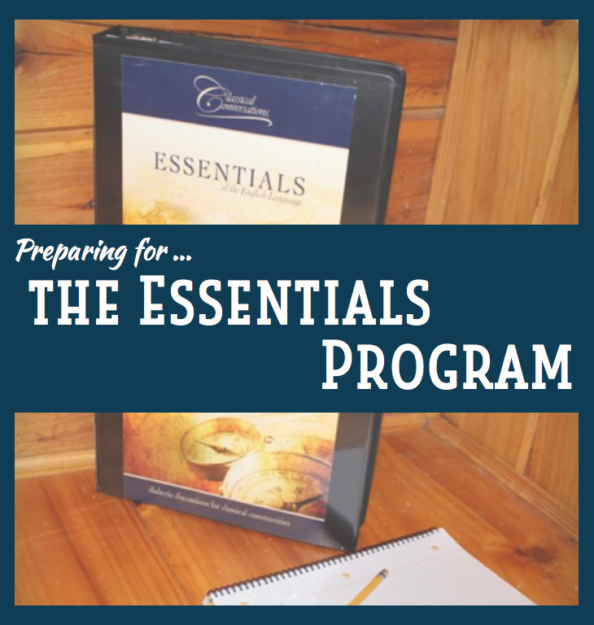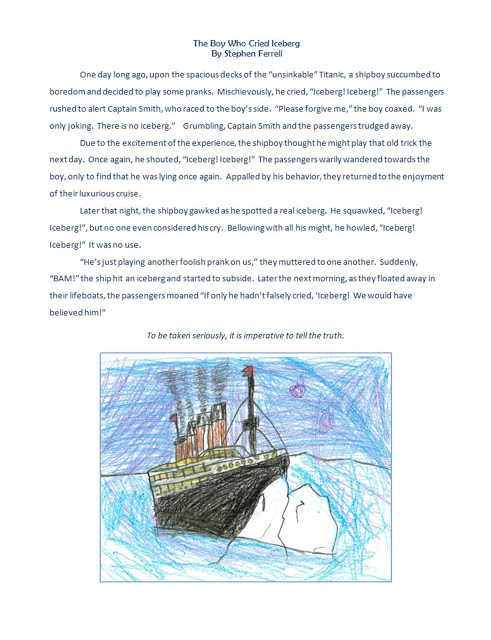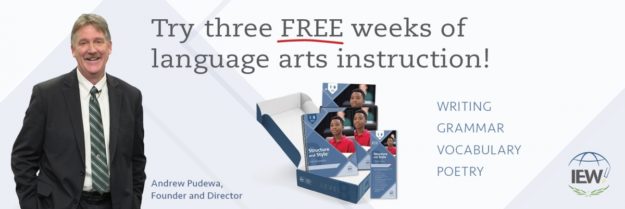
There are three main portions to the Essentials program:
- English Grammar and Structure through the Essentials of the English Language Guide
- Writing Structure and Style through Institute for Excellence in Writing
- Math practice through games and competition
Rather than go into a long-winded explanation of what Essentials is, I leave you with this at-a-glance info sheet from Classical Conversations. The Essentials of the English Language (EEL) Guide is only available to those enrolled in a Classical Conversations Essentials Program. You can purchase the History-Based Writing Lessons from IEW:
- Ancient History-Based Writing Lessons (Cycle 1)
- Medieval-Based Writing Lessons (Cycle 2)
- U.S. History-Based Writing Lessons (Cycle 3)
I recommend purchasing the history-based writing lessons directly from IEW because of their 100% Money-Back Guarantee.
What happened during our first year of Essentials (aka, my failure)
As a mom who was given a mandate (from her husband) to let go of Essentials mid-year (mainly because the writing portion of Essentials was taking too much undivided time and everyone’s frustration was escalating), I just want to say:
- The better organized you are with Essentials, the better success you will have.
- Find a structured plan that works for you and stick to it. (Don’t wait until the last day to write an entire paper from scratch.)
- For Essentials charts, abbreviations are OKAY. Don’t stress your child out when he’s not sure how to spell words like “interrogative.”
- For IEW, feel free to scale back! Our 3rd grader was sitting next to a 12th grader. Even though I tried to keep him from making comparisons, he still kept comparing himself to others. (For those children who do not want you to scale back, you don’t have to tell them you’re scaling back.)
- Be patient. It’s okay to spoon-feed words to your child when you are first showing him/her how to write. We are modeling quality writing for them, and they will be taking ownership of these writing techniques over time as we model quality writing for them. Be sure to listen to the many audio talks offered by Andrew Pudewa, and even subscribe to the podcast! Andrew Pudewa offers great encouragement and insight! He’s one of our absolute favorite speakers! (Even our teenagers enjoy listening to him!) I’d even encourage you to stick with Pudewa’s EZ+1 method, regardless of what the rest of the Essentials class is doing. After all, you’re aiming for mastery.
- Your child does not have to write everything out himself, nor does he need to have typing skills (though it would be nice!). If you have a reluctant writer, allow him to use the creative part of his brain dictating what he wants to say in his paper. You, as the parent, can write down what he says or type it. Then he can take over as you modify it for dress-ups together. For some people, thinking about what you want to say and writing it down on paper at the same time can cause the brain to overload. Because they are often too difficult to complete together, we practice penmanship and spelling separately from our other language arts skills. A great program to help students understand how to edit and proofread is Fix It Grammar. (Our family loves this program!)
- Whatever is needed, equip your child to feel successful. You do not want him to absolutely dread writing for the rest of his life. Learn together. Laugh together. Enjoy the time as you learn how to write better together.
- Essentials is just one of many language arts programs. If it doesn’t work for you or your child, there are other great options out there.
The Confession
To be honest, I did not look ahead like I should have. If I had found a way to scale back the biography Faces of History writing assignment and make it a fun learning experience for my child, we would have had a much better chance of success. But I also did not stick to our original Essentials plans after the Christmas break, which resulted in a chaotic approach to teaching IEW, which does not seem to work very well. Consistency is key!
Next year, I will follow the plan. It worked so well first semester. But I allowed us to fall so far behind during the spring semester that we were completely stressed out when my husband intervened and called for a principal-teacher conference at Half-a-Hundred Acre Wood Homeschool. He overruled my decision. I cried. But he was right. And I thank him for his wisdom because we have now regrouped and are finally looking forward to language arts again in the fall.
I offer here a little of what I’ve learned in preparing for Essentials. But I am not an Essentials Tutor. I am just a Mom who failed at the first go-round and am using that experience to hopefully help others.
Note: This article was written in 2012 referencing the 4th Edition of the EEL Guide (not the 4th Edition Revised). This means the page numbers may be off about 2 pages if you have the Revised Edition.
A way to Organize the Essentials Notebook
Materials Needed:
- Essentials of the English Language (EEL) Guide
- 2.5″ Binder
- 31-Tab Index Dividers
After using tabs 1-24 for weekly lessons 1-24, label the continuing tabs with a sticker over the number to mark the following sections like this…
Tab – Label
#25 – Abbreviations
#26 – Scope & Sequence
#27 – Master Charts
#28 – Weekly Sentences
#29 – Task Sheets
#30 – 8 Parts of Speech
#31 – Adv. (advanced) Verb Charts
Put each tab in front of the appropriate sections. You may choose to use the extra tabs (#25 – #31) a little differently than the above suggestion. Whatever works best for your family!
A Way to Organize the IEW Student Resource Notebook
(Free download with purchase of IEW History Student History-Based Writing Lessons – a necessity in my opinion! The Student Resource Notebook or Student Resource Packet has changed in recent years. Before making these tabs, ensure that your version of the SRN matches up with this organization.)
Materials Needed:
- Print-out of IEW Student Resource Notebook (You will need to download this with a code provided inside your IEW Student Workbook.)
- 1.5″ Binder
- 10 Index Dividers
Label tabs as follows:
- Stylistic Techniques
- Models of Structure
- Strong Verbs
- -ly Words
- Quality Adjectives
- Five Senses & Emotions
- Decorations
- Transitional Words & Phrases
- Grammar Rules
- Charts & Checklists
NOTE: I did not organize our Student Resource Notebook and should have. It would have helped us out very much.
ANOTHER NOTE: My son really enjoyed using a digital thesaurus – something about using technology to look up synonyms. I know i-pads also have this functionality, but we are still in the land of way-way-back-there when it comes to technology.
Make a Student Practice Workbook (Optional)
You may want to make a student practice workbook (for practice with dry erase markers instead of using up tons of paper).
Materials Needed:
- 1-inch Binder
- 35 Clear Page Protectors
- 10 Index Dividers (Optional – to easily and quickly find everything.)
From EEL Guide, make copies of the sheets listed below, place inside page protectors, and store each behind the appropriate index divider (if using index dividers).
- Page 394: Glossary of Abbreviations Reference
- Page 395: Scope & Sequence
- Pages 398 – 431: Master Charts (NOTE: I had to make a bigger version of “112 Model Sentences” Chart and “Verb Anatomy” Chart. Click the linked text to download.)
- Pages 433 – 434: Weekly Practice Sentences
- Pages 435 – 436: Analytical Task Sheet
- Page 437: Quid et Quo Basic Chart
- Page 439: Quid et Quo Detailed Chart
- Page 443: Parts of Speech Reference
- Page 457: Punctuation & Capitalization Reference
- From IEW Student Resource Notebook Download: Pages from Grammar Rules Section. Student may practice one Grammar Rule per week (which will allow you to do this twice over the course of the year – with only one extra rule per semester). You may also include the Decorations section because there are activities in this section for practice as well. [Update: The 2018 edition of the Student Resource Notebook no longer includes the Grammar Rules section.]
Skills before Essentials
If you are offered an opportunity to attend a free 2-Day “Popcorn & Pudewa” Seminar to watch the IEW Syllabus DVDs, take it! This was a tremendous encouragement, especially for a mother of a non-writer! I’ve watched the DVDs multiple times because there is so much to glean from it!
The writing element would have been much better for our son if we had used Fables, Myths, and Fairy Tales, Bible Heroes Writing Lessons, or People and Places in Our Community prior to using the history-based writing lessons. (We used Bible Heroes with our second son which made the transition much smoother!) Some other skills that would be helpful to know or practice before entering Essentials
- Memorize all three cycles of English grammar memory work from Foundations.
- Identify parts of speech in a sentence.
- Understand what an adjective and adverb are and what they modify.
- Distinguish between phrases and clauses.
- Distinguish between independent and subordinate clauses.
- Determine what a phrase or subordinate clause modifies.
- Identify dress-ups: quality adjectives, -ly words, and strong verbs.
- Identify decorations: similes, metaphors, personification, and alliteration
- Rewrite dull sentences using dress-ups and decorations
Some places to find practice sheets
- Adjective Practice
- Adverb Practice
- English for Everyone workbooks and worksheets
- KISS Grammar
- Cycle 1 English Grammar Resources
- Cycle 2 English Grammar Resources
- Cycle 3 English Grammar Resources
- Identifying decorations and dress-ups in reading (an activity for our Sign of the Beaver Book Club that can be applied to any reading assignment).
And it would be helpful to learn to type using a program like How-to-Type.com. Also visit Institute for Excellence in Writing and create a free account to download audio and pdf freebies. And be sure to “Like” Institute for Excellence in Writing on Facebook so that you can receive announcements of their free webinars.
Even with half a year of the IEW writing portion of Essentials, our oldest son walked away knowing how to write better, and that has carried over into all other aspects of writing. He notices when he uses a banned word or when he uses words repetitively, even when he is just writing a letter to his cousin. His writing improved drastically just from 14 weeks with the IEW program.
Here I offer a sample of Stephen’s writing (and illustration). Let me remind you, he is NOT a writer. As you can see, he is a master at completing his IEW checklist in as little writing as possible. Even though this process normally takes a lot of coaching, this particular assignment was mostly his work from our “Borrow a Conflict” writing assignment.
Try out Writing, Spelling, Poetry, and Grammar Programs for Free!
We highly recommend checking out the first three weeks of Structure & Style for Students program from IEW. (You can access the first three weeks free.)
Other IEW programs you can try out for free include…
- Structure and Style for Students. If you’d prefer Andrew Pudewa to teach writing structure and style to your student(s), this program is for you! Download the first lessons from each level for teaching composition to children in grades 3-12.
- Fix It! Grammar. Download the first lessons of all four levels of this gentle introduction to grammar and mechanics with thorough yet simple instructions for the teacher.
- Introduction to Public Speaking. Download the first two lessons of this engaging program for learning to conquer the #1 fear of most people: public speaking.
- University-Ready Writing is a 12-week video-based course which teaches high school students advanced note-taking skills and writing techniques in preparation for college-level writing. Try it free here!
- Theme-Based Writing Lessons. Theme-Based Writing Lessons are for students and/or teachers familiar with IEW’s Structure and Style Program. Topics include science, history, literature, and Bible, covering a variety of grade levels.
- Linguistic Development through Poetry Memorization. Download the first five poems from this mastery approach to learning poetry.
- The Phonetic Zoo. Try a sample of a program that teaches spelling with an auditory approach towards mastery. (Requires free registration.)
- Free audio talks, booklists, and more! (Our favorite audio is Nurturing Competent Communicators.)
Visit IEW to find out more about other programs to transform your students into proficient writers – from early elementary all the way through college! You may also be interested in our favorite resources for teaching grammar and composition to students in grades 3-12. Because of IEW’s incredible 100% Money-Back Guarantee, we highly recommend purchasing products directly from IEW instead of through 3rd-party sellers.
For more on how to plan for Essentials, visit Essentials: A First Year Survival Guide.
For other posts on Essentials visit:
Our Essentials Student Notebook
The Stick-and-the-Sand and Your Essentials Guide
Our Essentials Experience – How to Scale Back


